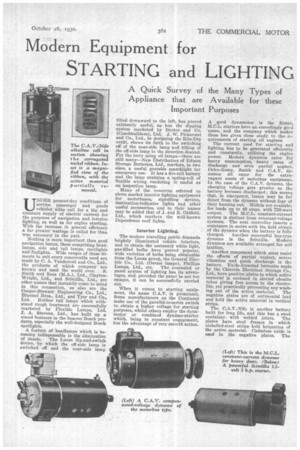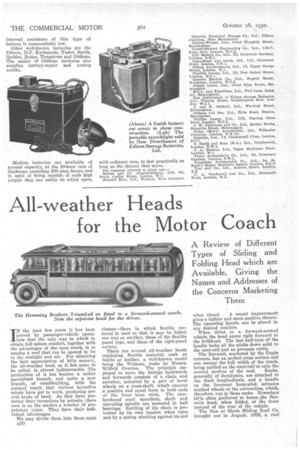Modern Equipment for
Page 107

Page 108

If you've noticed an error in this article please click here to report it so we can fix it.
STARTING and LIGHTING A Quick Survey, of the Many Types of Appliance that are Available for these Important Purposes UNDER present-day conditions of service passenger and goods vehicles alike call for a big and constant supply of electric current for the purposes of navigation and interior lighting, as well as for engine starting. With the increase in general efficiency a far greater wattage is called for than was necessary in the past. '
Nothing is more important than good navigation lamps, these comprising headlamps, side and tail lamps, spotlights and foglights. Wide ranges of these fitments to suit every conceivable need are made by C. A. Vandervell and Co., Ltd., the products of which company are known and used the world over. S. Smith and Sons (M.A.), Ltd., ClaytonWright, Ltd. and Scintilla, Ltd., are other names that instantly come to mind in this connection, as also are the Cooper-Stewart Engineering Co., Ltd., Bluemel Bros., Ltd., and Tyer and Co., Ltd. Rubber tail lamps which withstand rough treatment are successfully marketed by Flexible Lampe, Ltd. J. A. Stevens, Ltd., has built up a sound business in the famous Bosch products, especially the well-designed Bosch spotlights.
A feature of headlamps which is becoming indispensable is the elimination of dazzle. The Lucas dip-and-switch device, by which the off-side lamp is switched off and the near-side lamp tilted downward to the left, has proved extremely useful, as has the dipping system marketed by Barker and Co. (Coachlmilders), Ltd. J. W. Pickavant and Co., Ltd., in designing the Rite-Dip outfit, shows its faith in the switching off of the near-side lamp and tilting of the off-side lamp in the direction desired. For the lorry using oil lamps—there are still many—New Distributors of Edison Storage Batteries, Ltd. markets, in two sizes, a useful portable searchlight for emergency use. It has a five-cell battery and the lamp contains a spring-roll of flexible wiring rendering it useful as an inspection lamp.
Many of the concerns referred to above market interior lighting equipment for motorbuses, signalling devices, destination-indicator lights and other useful accessories, and to their names may be added that of J. and R. Oldfield, Ltd., which markets the well-known Dependence roof lights.
Interior Lighting.
The modern travelling public demands brightly illuminated vehicle interiors, and to obtain the necessary white light, gas-filled bulbs have proved popular, wide varieties of bulbs being obtainable from the. Lucas group, the General Electric Co., Ltd. (Ceram lamps), Phillips Lamps, Ltd., etc. The concealed or panel system of lighting has its advantages, and. provided the panel be not too opaque, it can be successfully carried out.
When it comes to starting equipment, the name C.A.V. is prominent. Some manufacturers on the Continent make use of the parallel-to-series switch to obtain a higher voltage for starting purposes, whilst others employ the dynemotpr or combined dynteno-starter which, being in _constant engagement, has the advantage of very smooth action.
A good dynamotor is the Rotax. M.C.L. starters have an exceedingly good -name, and the company which makes them has given close study to the requirements of starting oil engines.
The current used for starting and lighting has to be generated efficiently and constantly, utilizing the engine power. Modern dynamos cater for heavy consumption, heavy rates of discharge and even partial neglect. Delco-Remy, Smith and C.A.V. dynamos all cater for the extravagant needs of motorbus equipment. In the case of the C.A.V. dynamo, the charging voltage gets greater as the battery becomes discharged ; this means that, in emergency, lamps may be fed direct from the dynamo without fear of their burning out. Models are available for loads up to 48 amps. with 720-watt output. The M.O.L. constant-current system is distinct from constant-voltage systems. The neat controller inserts a resistance in series with the field circuit of the dynamo when the battery is fully charged. Another successful bus-type dynamo is the Scintilla. Modern dynamos are available arranged for coil Another component which must resist the effects of partial neglect, severe vibration and quick discharge is the battery. Exide-Ironclad batteries made by the Chloride Electrical Storage Co., Ltd., have positive plates in which active material is enclosed in slotted ebonite tubes giving free access to the electrolite, yet practically preventing any wash ing out of the active material. The negative plates are of antimonial lead and hold the active material in vertical strips.
The C.A.V.-Nife is another battery built for long life, and this has a steel container with welded joints. The plates have steel frames in which nickelled-stool strips hold briquettes of the active material. Cadmium oxide is used in the negative plates. Thu
Internal resistance of this type of battery is commendably low.
Other well-known batteries are the Edison, D.P. Kathanode, Tudor, Smith, Quikko, Rotax, Tungstone and Oldham. The maker of Oldham batteries also supplies battery-repair and testing outfits.
Modern batteries are available of normal capacity, at the 10-hour rate of discharge, exceeding 200 amp.-hours, and in spite of being capable of such high output they can safely be relied upon, with ordinary care, to last practically as long as the chassis they serve.
The concerns referred to above are:—
Barker and Co. (Coacbbnildera), Ltd., 66, South Audley Street, London, W.1. Bluemel Bros., Ltd., Walston, Near Coventry. Chloride Electrical Storage Co., Ltd., Clifton Junction, Near Manchester. Clayton-Wright, Ltd., Great Hampton Street, Birmingham. .
Cooper-Stewart Engineering CO., Ltd., 136-7, Long Acre, London' W.C.2.
D.P. Battery Co., Ltd.. 50, Grosvenor Gardens, Landon, S.W.1.
Delco-Remy and ttyatt, Ltd., 111, Grosvenor Road, London, SW.].. Edison Accumulators, Ltd., 15, Upper George Street, London, W.1. Flexible Lamps, Ltd., 59, New Oxford Street, London, W.C.1.
General Electric Co., Ltd., Magnet House, Kingsway, London, W.C.2. Joesph Lucas, Ltd., Great King Street, Birmingbair M.C.L. and Repetition, Ltd., Pool Lane, Langley, Birmingham.
New Distributors of Edison Storage Batteries, Ltd., Victoria House, Southampton Row, London, W.C.1.
J. and R. Oldfield, Ltd., Warwick Street, Birmingham. Oldham and Son, Ltd., Hyde Road, Denton, Manchester.
Phillips Lamps, Ltd., 145, Charing Creels Road, London, W.C.2.
J. W. Pickavant and Co., Ltd., Quikko Works; Granville Street, Birmingham.
Rotax (Motor Accessories). Ltd., Willesden Junction, London, N.W.10. • Scintilla, Ltd., 14, Clerkenwell Close, Landon, E.0.1. • S. Smith and Sons (M.A.), Ltd., Crioklewood, London, N.W.2. J. A. Stevens, Ltd., Upper Rathboue Place. London, W.1. Tudor Accumulator Go., Ltd., 50, Grosvenor Gardens, London, S.W.1. Tungstone Accumulator Co., Ltd.,34-, St. Bride's House.-Salisbury Square, London, E.C.4. Tyer and Co., Ltd., Ashwin Street, London, E.S. • C. A. Vandervell -and Co., Ltd., Dordrecht Road, London, W.3.




















































































































































































